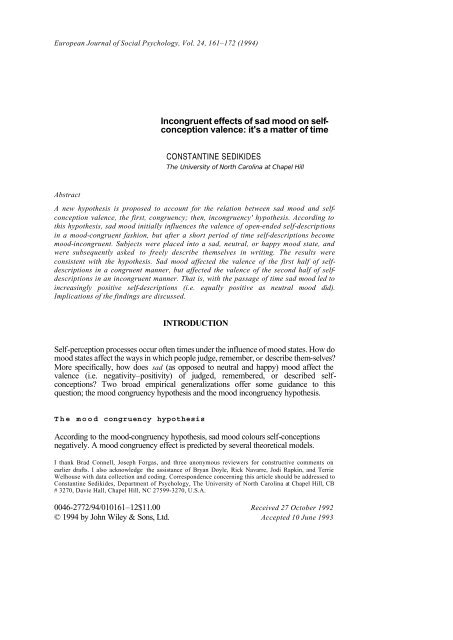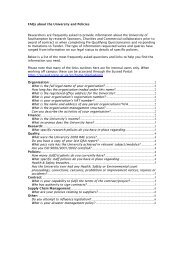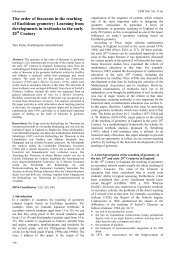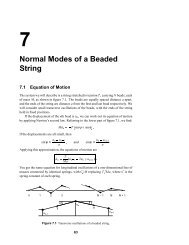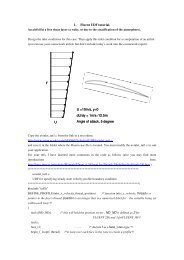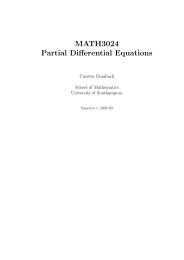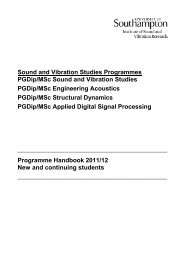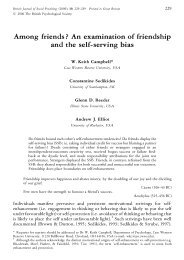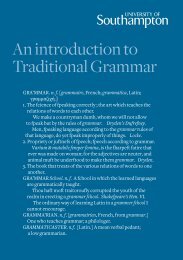Incongruent effects of sad mood on self- conception ... - ResearchGate
Incongruent effects of sad mood on self- conception ... - ResearchGate
Incongruent effects of sad mood on self- conception ... - ResearchGate
You also want an ePaper? Increase the reach of your titles
YUMPU automatically turns print PDFs into web optimized ePapers that Google loves.
European Journal <str<strong>on</strong>g>of</str<strong>on</strong>g> Social Psychology, Vol. 24, 161–172 (1994)<br />
<str<strong>on</strong>g>Inc<strong>on</strong>gruent</str<strong>on</strong>g> <str<strong>on</strong>g>effects</str<strong>on</strong>g> <str<strong>on</strong>g>of</str<strong>on</strong>g> <str<strong>on</strong>g>sad</str<strong>on</strong>g> <str<strong>on</strong>g>mood</str<strong>on</strong>g> <strong>on</strong> <strong>self</strong>c<strong>on</strong>cepti<strong>on</strong><br />
valence: it's a matter <str<strong>on</strong>g>of</str<strong>on</strong>g> time<br />
CONSTANTINE SEDIKIDES<br />
The University <str<strong>on</strong>g>of</str<strong>on</strong>g> North Carolina at Chapel Hill<br />
Abstract<br />
A new hypothesis is proposed to account for the relati<strong>on</strong> between <str<strong>on</strong>g>sad</str<strong>on</strong>g> <str<strong>on</strong>g>mood</str<strong>on</strong>g> and <strong>self</strong>c<strong>on</strong>cepti<strong>on</strong><br />
valence, the first, c<strong>on</strong>gruency; then, inc<strong>on</strong>gruency' hypothesis. According to<br />
this hypothesis, <str<strong>on</strong>g>sad</str<strong>on</strong>g> <str<strong>on</strong>g>mood</str<strong>on</strong>g> initially influences the valence <str<strong>on</strong>g>of</str<strong>on</strong>g> open-ended <strong>self</strong>-descripti<strong>on</strong>s<br />
in a <str<strong>on</strong>g>mood</str<strong>on</strong>g>-c<strong>on</strong>gruent fashi<strong>on</strong>, but after a short period <str<strong>on</strong>g>of</str<strong>on</strong>g> time <strong>self</strong>-descripti<strong>on</strong>s become<br />
<str<strong>on</strong>g>mood</str<strong>on</strong>g>-inc<strong>on</strong>gruent. Subjects were placed into a <str<strong>on</strong>g>sad</str<strong>on</strong>g>, neutral, or happy <str<strong>on</strong>g>mood</str<strong>on</strong>g> state, and<br />
were subsequently asked to freely describe themselves in writing. The results were<br />
c<strong>on</strong>sistent with the hypothesis. Sad <str<strong>on</strong>g>mood</str<strong>on</strong>g> affected the valence <str<strong>on</strong>g>of</str<strong>on</strong>g> the first half <str<strong>on</strong>g>of</str<strong>on</strong>g> <strong>self</strong>descripti<strong>on</strong>s<br />
in a c<strong>on</strong>gruent manner, but affected the valence <str<strong>on</strong>g>of</str<strong>on</strong>g> the sec<strong>on</strong>d half <str<strong>on</strong>g>of</str<strong>on</strong>g> <strong>self</strong>descripti<strong>on</strong>s<br />
in an inc<strong>on</strong>gruent manner. That is, with the passage <str<strong>on</strong>g>of</str<strong>on</strong>g> time <str<strong>on</strong>g>sad</str<strong>on</strong>g> <str<strong>on</strong>g>mood</str<strong>on</strong>g> led to<br />
increasingly positive <strong>self</strong>-descripti<strong>on</strong>s (i.e. equally positive as neutral <str<strong>on</strong>g>mood</str<strong>on</strong>g> did).<br />
Implicati<strong>on</strong>s <str<strong>on</strong>g>of</str<strong>on</strong>g> the findings are discussed.<br />
INTRODUCTION<br />
Self-percepti<strong>on</strong> processes occur <str<strong>on</strong>g>of</str<strong>on</strong>g>ten times under the influence <str<strong>on</strong>g>of</str<strong>on</strong>g> <str<strong>on</strong>g>mood</str<strong>on</strong>g> states. How do<br />
<str<strong>on</strong>g>mood</str<strong>on</strong>g> states affect the ways in which people judge, remember, or describe them-selves?<br />
More specifically, how does <str<strong>on</strong>g>sad</str<strong>on</strong>g> (as opposed to neutral and happy) <str<strong>on</strong>g>mood</str<strong>on</strong>g> affect the<br />
valence (i.e. negativity–positivity) <str<strong>on</strong>g>of</str<strong>on</strong>g> judged, remembered, or described <strong>self</strong>c<strong>on</strong>cepti<strong>on</strong>s?<br />
Two broad empirical generalizati<strong>on</strong>s <str<strong>on</strong>g>of</str<strong>on</strong>g>fer some guidance to this<br />
questi<strong>on</strong>; the <str<strong>on</strong>g>mood</str<strong>on</strong>g> c<strong>on</strong>gruency hypothesis and the <str<strong>on</strong>g>mood</str<strong>on</strong>g> inc<strong>on</strong>gruency hypothesis.<br />
The <str<strong>on</strong>g>mood</str<strong>on</strong>g> c<strong>on</strong>gruency hypothesis<br />
According to the <str<strong>on</strong>g>mood</str<strong>on</strong>g>-c<strong>on</strong>gruency hypothesis, <str<strong>on</strong>g>sad</str<strong>on</strong>g> <str<strong>on</strong>g>mood</str<strong>on</strong>g> colours <strong>self</strong>-c<strong>on</strong>cepti<strong>on</strong>s<br />
negatively. A <str<strong>on</strong>g>mood</str<strong>on</strong>g> c<strong>on</strong>gruency effect is predicted by several theoretical models.<br />
I thank Brad C<strong>on</strong>nell, Joseph Forgas, and three an<strong>on</strong>ymous reviewers for c<strong>on</strong>structive comments <strong>on</strong><br />
earlier drafts. I also acknowledge the assistance <str<strong>on</strong>g>of</str<strong>on</strong>g> Bryan Doyle, Rick Navarre, Jodi Rapkin, and Terrie<br />
Welhouse with data collecti<strong>on</strong> and coding. Corresp<strong>on</strong>dence c<strong>on</strong>cerning this article should be addressed to<br />
C<strong>on</strong>stantine Sedikides, Department <str<strong>on</strong>g>of</str<strong>on</strong>g> Psychology, The University <str<strong>on</strong>g>of</str<strong>on</strong>g> North Carolina at Chapel Hill, CB<br />
# 3270, Davie Hall, Chapel Hill, NC 27599-3270, U.S.A.<br />
0046-2772/94/010161–12$11.00 Received 27 October 1992<br />
© 1994 by John Wiley & S<strong>on</strong>s, Ltd. Accepted 10 June 1993
162 C. Sedikides<br />
These models differ in terms <str<strong>on</strong>g>of</str<strong>on</strong>g> the postulated mechanism through which the <str<strong>on</strong>g>mood</str<strong>on</strong>g><br />
c<strong>on</strong>gruency effect is obtained. The models can be classified broadly as cognitive or<br />
motivati<strong>on</strong>al. The most well-known and empirically supported''' cognitive models are<br />
the <str<strong>on</strong>g>mood</str<strong>on</strong>g>-priming or network models (Bower, 1981, 1991; Clark and Isen, 1982; Isen<br />
1984). According to these models, <str<strong>on</strong>g>sad</str<strong>on</strong>g> <str<strong>on</strong>g>mood</str<strong>on</strong>g> primes and thus renders accessible in<br />
memory <strong>self</strong>-relevant informati<strong>on</strong> that is valuatively c<strong>on</strong>gruent with the <str<strong>on</strong>g>mood</str<strong>on</strong>g> (i.e.<br />
negative). This informati<strong>on</strong>, in turn, forms the basis for subsequent (and similarlyvalenced)<br />
retrieval or judgments <str<strong>on</strong>g>of</str<strong>on</strong>g> <strong>self</strong>-c<strong>on</strong>cepti<strong>on</strong>s. Motivati<strong>on</strong>al models (Mischel,<br />
Coates and Rask<str<strong>on</strong>g>of</str<strong>on</strong>g>f, 1968; Mischel, Ebbesen and Zeiss, 1976) capitalize <strong>on</strong> the<br />
assumpti<strong>on</strong> that humans are motivated to maintain their current affective state. Mood<br />
induces a global sense <str<strong>on</strong>g>of</str<strong>on</strong>g> <str<strong>on</strong>g>sad</str<strong>on</strong>g>ness that humans maintain through judging or retrieving<br />
<strong>self</strong>-c<strong>on</strong>cepti<strong>on</strong>s in a valuatively c<strong>on</strong>gruent manner.<br />
The <str<strong>on</strong>g>mood</str<strong>on</strong>g> inc<strong>on</strong>gruency hypothesis<br />
The relati<strong>on</strong> between <str<strong>on</strong>g>mood</str<strong>on</strong>g> and <strong>self</strong>-c<strong>on</strong>cepti<strong>on</strong> valence can also be stated in terms <str<strong>on</strong>g>of</str<strong>on</strong>g><br />
the <str<strong>on</strong>g>mood</str<strong>on</strong>g>-inc<strong>on</strong>gruency hypothesis 3 (Clark and Isen, 1982; Forgas, 1991; Isen, 1984).<br />
This motivati<strong>on</strong>ally-oriented formulati<strong>on</strong> proposes that people in a <str<strong>on</strong>g>sad</str<strong>on</strong>g> <str<strong>on</strong>g>mood</str<strong>on</strong>g> will<br />
attempt to exit their aversive <str<strong>on</strong>g>mood</str<strong>on</strong>g> state through regulatory strategies, such as positive<br />
thinking, <strong>self</strong>-reward, rati<strong>on</strong>alizati<strong>on</strong>, or external distracti<strong>on</strong> (Frijda, 1986; Morris and<br />
Reilly, 1987; Scheler, and Carver, 1982). These strategies will result in increased<br />
positivity <str<strong>on</strong>g>of</str<strong>on</strong>g> <strong>self</strong>-c<strong>on</strong>cepti<strong>on</strong>s.<br />
Mood <str<strong>on</strong>g>effects</str<strong>on</strong>g> <strong>on</strong> <strong>self</strong>-c<strong>on</strong>cepti<strong>on</strong> valence as a functi<strong>on</strong> <str<strong>on</strong>g>of</str<strong>on</strong>g> time delay: first, c<strong>on</strong>gruency;<br />
then inc<strong>on</strong>gruency<br />
One potential weakness <str<strong>on</strong>g>of</str<strong>on</strong>g> tests <str<strong>on</strong>g>of</str<strong>on</strong>g> the <str<strong>on</strong>g>mood</str<strong>on</strong>g> c<strong>on</strong>gruency versus <str<strong>on</strong>g>mood</str<strong>on</strong>g> inc<strong>on</strong>gruency<br />
hypothesis (see Sedikides (1922a) for a review) is their lack <str<strong>on</strong>g>of</str<strong>on</strong>g> attenti<strong>on</strong> to time delay.<br />
Dependent measures (e.g. judgments <str<strong>on</strong>g>of</str<strong>on</strong>g> <strong>self</strong>-relevant attributes, expectancies about<br />
future own behaviour, autobiographical recall) are typically collected <strong>on</strong>ce, that is,<br />
immediately following the <str<strong>on</strong>g>mood</str<strong>on</strong>g> inducti<strong>on</strong> procedure. Alterati<strong>on</strong>s in <strong>self</strong>-c<strong>on</strong>cepti<strong>on</strong><br />
valence are not typically examined as a functi<strong>on</strong> <str<strong>on</strong>g>of</str<strong>on</strong>g> time delay.<br />
A serious c<strong>on</strong>siderati<strong>on</strong> <str<strong>on</strong>g>of</str<strong>on</strong>g> the time delay factor invites new challenges to the form<br />
and empirical testing <str<strong>on</strong>g>of</str<strong>on</strong>g> the <str<strong>on</strong>g>mood</str<strong>on</strong>g>-c<strong>on</strong>gruency vis-a-vis <str<strong>on</strong>g>mood</str<strong>on</strong>g>-inc<strong>on</strong>gruency<br />
' Other cognitive models propose that <str<strong>on</strong>g>mood</str<strong>on</strong>g>-c<strong>on</strong>gruency <str<strong>on</strong>g>effects</str<strong>on</strong>g> are either due to the informati<strong>on</strong> embedded in<br />
<str<strong>on</strong>g>mood</str<strong>on</strong>g> manipulati<strong>on</strong>s (rather than <str<strong>on</strong>g>mood</str<strong>on</strong>g> per se) acting as a prime (Riskind, 1983), or to subjects' compliant<br />
and c<strong>on</strong>scious efforts to maintain and even boost their <str<strong>on</strong>g>mood</str<strong>on</strong>g> (Blaney, 1986). However, these models have<br />
not been empirically supported (Parrott, 1991).<br />
s Two other models, the <str<strong>on</strong>g>mood</str<strong>on</strong>g>-as-informati<strong>on</strong> view (Schwarz and Clore, 1988) and the multiprocess<br />
model (Forgas, 1992), are not presented in depth here, because they are tangential to the purposes <str<strong>on</strong>g>of</str<strong>on</strong>g> this<br />
research. These models predict interactive <str<strong>on</strong>g>effects</str<strong>on</strong>g> <str<strong>on</strong>g>of</str<strong>on</strong>g> <str<strong>on</strong>g>mood</str<strong>on</strong>g> states and stimulus complexity, and thus<br />
presuppose manipulati<strong>on</strong> <str<strong>on</strong>g>of</str<strong>on</strong>g> the complexity <str<strong>on</strong>g>of</str<strong>on</strong>g> the stimulus field, something that the reported research did<br />
not accomplish.<br />
' Two other hypotheses, the <str<strong>on</strong>g>mood</str<strong>on</strong>g> repair and negative state relief (Carls<strong>on</strong> and Miller, 1987) hypotheses,<br />
make similar predicti<strong>on</strong>s with the <str<strong>on</strong>g>mood</str<strong>on</strong>g>-inc<strong>on</strong>gruency hypothesis. Nevertheless, the term <str<strong>on</strong>g>mood</str<strong>on</strong>g> inc<strong>on</strong>gruency<br />
was preferred. Whereas the <str<strong>on</strong>g>mood</str<strong>on</strong>g> repair and negative state relief hypotheses propose regulatory<br />
processes for the purpose <str<strong>on</strong>g>of</str<strong>on</strong>g> modifying the displeasing <str<strong>on</strong>g>mood</str<strong>on</strong>g>, the <str<strong>on</strong>g>mood</str<strong>on</strong>g> inc<strong>on</strong>gruency hypothesis proposes<br />
regulatory processes that aim at altering either the <str<strong>on</strong>g>sad</str<strong>on</strong>g> <str<strong>on</strong>g>mood</str<strong>on</strong>g> or the negativ e <strong>self</strong>-c<strong>on</strong>cepti<strong>on</strong>s that predominate<br />
at the time (See secti<strong>on</strong> Mood <str<strong>on</strong>g>effects</str<strong>on</strong>g> <strong>on</strong> <strong>self</strong>-c<strong>on</strong>cepti<strong>on</strong> valence as a functi<strong>on</strong> <str<strong>on</strong>g>of</str<strong>on</strong>g> time delay: first<br />
c<strong>on</strong>gruency; then, Inc<strong>on</strong>gruency).
First, c<strong>on</strong>gruency; then, inc<strong>on</strong>gruency 163<br />
c<strong>on</strong>troversy. Imagine a case where subjects are induced into a <str<strong>on</strong>g>sad</str<strong>on</strong>g> <str<strong>on</strong>g>mood</str<strong>on</strong>g> state and<br />
are subsequently asked to openly describe themselves over a relatively extended time<br />
period. I propose that, in this case, <str<strong>on</strong>g>sad</str<strong>on</strong>g> <str<strong>on</strong>g>mood</str<strong>on</strong>g> is likely to exert initially c<strong>on</strong>gruent<br />
<str<strong>on</strong>g>effects</str<strong>on</strong>g> <strong>on</strong> <strong>self</strong>-descripti<strong>on</strong> valence, followed by inc<strong>on</strong>gruent <str<strong>on</strong>g>effects</str<strong>on</strong>g>. This scenario<br />
will be labelled the `first, c<strong>on</strong>gruency; then, inc<strong>on</strong>gruency' hypothesis.<br />
How could a `first, c<strong>on</strong>gruency; then, inc<strong>on</strong>gruency' scenario be accounted for? At<br />
least two explanati<strong>on</strong>s are plausible. One explanati<strong>on</strong> asserts that <str<strong>on</strong>g>sad</str<strong>on</strong>g> <str<strong>on</strong>g>mood</str<strong>on</strong>g> primes<br />
negative <strong>self</strong>-c<strong>on</strong>cepti<strong>on</strong>s, which figure in subjects' negative overt <strong>self</strong>-descripti<strong>on</strong>s.<br />
However, with the passage <str<strong>on</strong>g>of</str<strong>on</strong>g> time, subjects become aware <str<strong>on</strong>g>of</str<strong>on</strong>g> a <str<strong>on</strong>g>mood</str<strong>on</strong>g>-induced bias in<br />
their <strong>self</strong>-descripti<strong>on</strong>s, and engage in <str<strong>on</strong>g>mood</str<strong>on</strong>g>-regulati<strong>on</strong>. Mood-regulati<strong>on</strong> entails<br />
subjects attempting to terminate their unpleasant <str<strong>on</strong>g>mood</str<strong>on</strong>g> state and entering into a<br />
happier <str<strong>on</strong>g>mood</str<strong>on</strong>g> by `resetting' the evidential base <strong>on</strong> which the <strong>self</strong>-descripti<strong>on</strong>s were<br />
based, leading to an increase in the positivity <str<strong>on</strong>g>of</str<strong>on</strong>g> <strong>self</strong>-descripti<strong>on</strong>s. Alternatively, with<br />
the passage <str<strong>on</strong>g>of</str<strong>on</strong>g> time subjects may engage in <strong>self</strong>-regulati<strong>on</strong>. The negative <strong>self</strong>descripti<strong>on</strong>s<br />
will reach a `critical mass', after which subjects become motivated to<br />
pursue a cognitive c<strong>on</strong>trast strategy (reminiscent <str<strong>on</strong>g>of</str<strong>on</strong>g> Martin, 1986), namely to access<br />
<strong>self</strong>-descripti<strong>on</strong>s that c<strong>on</strong>trast the previously accessed <strong>on</strong>es. This strategy will be<br />
fuelled by the <strong>self</strong>-enhancement motive (Sedikides, 1993a; Taylor and Brown, 1988)<br />
and will result in a switch-over from negative to positive <strong>self</strong>-descripti<strong>on</strong>s.<br />
Another explanati<strong>on</strong> <str<strong>on</strong>g>of</str<strong>on</strong>g> the `first, c<strong>on</strong>gruency; then, inc<strong>on</strong>gruency' scenario states<br />
that <str<strong>on</strong>g>sad</str<strong>on</strong>g>-<str<strong>on</strong>g>mood</str<strong>on</strong>g> subjects become overwhelmed and energy depleted due to the shocking<br />
<str<strong>on</strong>g>effects</str<strong>on</strong>g> <str<strong>on</strong>g>of</str<strong>on</strong>g> <str<strong>on</strong>g>sad</str<strong>on</strong>g> <str<strong>on</strong>g>mood</str<strong>on</strong>g> (Sedikides, 1992, p. 278) and are c<strong>on</strong>sequently unable in the<br />
short run to engage in cognitive strategies (e.g. <str<strong>on</strong>g>mood</str<strong>on</strong>g> regulati<strong>on</strong> or <strong>self</strong>-regulati<strong>on</strong>)<br />
that would alter their <str<strong>on</strong>g>mood</str<strong>on</strong>g>. Hence, their <strong>self</strong>-descripti<strong>on</strong>s are inevitably at the mercy<br />
<str<strong>on</strong>g>of</str<strong>on</strong>g> the valuative influence <str<strong>on</strong>g>of</str<strong>on</strong>g> <str<strong>on</strong>g>mood</str<strong>on</strong>g> and thus <str<strong>on</strong>g>mood</str<strong>on</strong>g> c<strong>on</strong>gruent. However, as time goes<br />
by, subjects will overcome their initial shock, regain their energy, and manage to cope<br />
with the situati<strong>on</strong> by becoming involved in either <str<strong>on</strong>g>mood</str<strong>on</strong>g>-management or <strong>self</strong>regulatory<br />
strategies. The result will be increasingly positive <strong>self</strong>-descripti<strong>on</strong>s.<br />
In summary, the `first, c<strong>on</strong>gruency; then, inc<strong>on</strong>gruency' hypothesis proposes that<br />
<str<strong>on</strong>g>sad</str<strong>on</strong>g>-<str<strong>on</strong>g>mood</str<strong>on</strong>g> subjects will begin describing themselves in a <str<strong>on</strong>g>mood</str<strong>on</strong>g>-c<strong>on</strong>gruent manner,<br />
but will progressively describe themselves as positively as neutral-<str<strong>on</strong>g>mood</str<strong>on</strong>g> subjects do<br />
(weak renditi<strong>on</strong> <str<strong>on</strong>g>of</str<strong>on</strong>g> the hypothesis) or even as happy-<str<strong>on</strong>g>mood</str<strong>on</strong>g> subjects do (str<strong>on</strong>g<br />
renditi<strong>on</strong> <str<strong>on</strong>g>of</str<strong>on</strong>g> the hypothesis). Thus, there will be more positive <strong>self</strong>-descripti<strong>on</strong>s in the<br />
sec<strong>on</strong>d half <str<strong>on</strong>g>of</str<strong>on</strong>g> subjects' protocols than in the first half. The `first, c<strong>on</strong>gruency; then,<br />
inc<strong>on</strong>gruency ' hypothesis was tested in the present experiment.<br />
PILOT STUDY<br />
It is crucial for the purposes <str<strong>on</strong>g>of</str<strong>on</strong>g> this investigati<strong>on</strong> to establish the time interval in<br />
which the induced <str<strong>on</strong>g>mood</str<strong>on</strong>g> states are maintained, so that a <str<strong>on</strong>g>mood</str<strong>on</strong>g> decay explanati<strong>on</strong> <str<strong>on</strong>g>of</str<strong>on</strong>g><br />
the obtained findings can be ruled out. This time interval should then be allotted to<br />
subjects for the <strong>self</strong>-descripti<strong>on</strong> task. I c<strong>on</strong>ducted a pilot study to accomplish this<br />
objective.<br />
The pilot study involved 48 University <str<strong>on</strong>g>of</str<strong>on</strong>g> Wisc<strong>on</strong>sin introductory psychology students<br />
who participated in exchange for extra course credit. Subjects were first induced<br />
into a state <str<strong>on</strong>g>of</str<strong>on</strong>g> <str<strong>on</strong>g>sad</str<strong>on</strong>g>, neutral, or happy <str<strong>on</strong>g>mood</str<strong>on</strong>g> (for more details, see secti<strong>on</strong>s The <str<strong>on</strong>g>mood</str<strong>on</strong>g><br />
inducti<strong>on</strong> task and Procedure). Next, subjects completed two assignments. Specifi-
164 C. Sedikides<br />
cally, they were asked to locate the names <str<strong>on</strong>g>of</str<strong>on</strong>g> famous psychologists hidden in a letter<br />
matrix for 4 min, and to write down as many <str<strong>on</strong>g>of</str<strong>on</strong>g> the United States as possible for<br />
another 2 min. Half <str<strong>on</strong>g>of</str<strong>on</strong>g> the subjects filled out three 9-point <str<strong>on</strong>g>mood</str<strong>on</strong>g>-assessing scales (<str<strong>on</strong>g>sad</str<strong>on</strong>g><br />
versus happy, depressed versus elated, gloomy versus c<strong>on</strong>tent) up<strong>on</strong> completi<strong>on</strong> <str<strong>on</strong>g>of</str<strong>on</strong>g> the<br />
first assignment (i.e. 4 min after the <str<strong>on</strong>g>mood</str<strong>on</strong>g> inducti<strong>on</strong> procedure), and the other half <str<strong>on</strong>g>of</str<strong>on</strong>g><br />
the subjects filled out the three scales up<strong>on</strong> completi<strong>on</strong> <str<strong>on</strong>g>of</str<strong>on</strong>g> the sec<strong>on</strong>d assignment (i.e.<br />
6 min after the <str<strong>on</strong>g>mood</str<strong>on</strong>g> inducti<strong>on</strong> procedure).<br />
Mood was sustained for 4 min following its inducti<strong>on</strong>, F(2,21) = 8.28, p < 0.002.<br />
Orthog<strong>on</strong>al c<strong>on</strong>trasts revealed that <str<strong>on</strong>g>sad</str<strong>on</strong>g>-<str<strong>on</strong>g>mood</str<strong>on</strong>g> subjects (M = 4.54) reported feeling<br />
significantly <str<strong>on</strong>g>sad</str<strong>on</strong>g>der than either neutral-<str<strong>on</strong>g>mood</str<strong>on</strong>g> subjects (M = 5.92), p < 0.008, or happy<str<strong>on</strong>g>mood</str<strong>on</strong>g><br />
subjects (M = 6.38), p < 0.001. Neutral-<str<strong>on</strong>g>mood</str<strong>on</strong>g> subjects reported feeling less happy<br />
than happy-<str<strong>on</strong>g>mood</str<strong>on</strong>g> subjects, but not significantly so, p < 0.34. Mood was also sustained<br />
for 6 min after its inducti<strong>on</strong>, F(2,21) = 4.93,p < 0.018. Orthog<strong>on</strong>al c<strong>on</strong>trasts showed<br />
that <str<strong>on</strong>g>sad</str<strong>on</strong>g>-<str<strong>on</strong>g>mood</str<strong>on</strong>g> subjects (M = 5.00) reported feeling <str<strong>on</strong>g>sad</str<strong>on</strong>g>der than neutral-<str<strong>on</strong>g>mood</str<strong>on</strong>g> subjects<br />
(M = 5.71), although n<strong>on</strong>-significantly so (p < 0.15), and <str<strong>on</strong>g>sad</str<strong>on</strong>g>der than happy-<str<strong>on</strong>g>mood</str<strong>on</strong>g><br />
subjects (M = 6.50), p < 0.005. Neutral-<str<strong>on</strong>g>mood</str<strong>on</strong>g> subjects reported feeling less happy than<br />
happy-<str<strong>on</strong>g>mood</str<strong>on</strong>g> subjects, but not significantly so, p < 0.11. Moreover, the interacti<strong>on</strong><br />
between <str<strong>on</strong>g>mood</str<strong>on</strong>g> and time delay (4 min versus 6 min) was not significant, F(2,42) =<br />
0.50, p < 0.61. The n<strong>on</strong>-significance <str<strong>on</strong>g>of</str<strong>on</strong>g> the interacti<strong>on</strong> is anticipated by the claim that<br />
<str<strong>on</strong>g>mood</str<strong>on</strong>g> was sustained for 6 min following its inducti<strong>on</strong>.<br />
METHOD<br />
Subjects and experimental design<br />
Subjects were 180 University <str<strong>on</strong>g>of</str<strong>on</strong>g> Wisc<strong>on</strong>sin undergraduates, who received extra introductory<br />
psychology credit for their participati<strong>on</strong>. Subjects were run individually and<br />
assigned randomly to the experimental c<strong>on</strong>diti<strong>on</strong>s. The experiment involved a 3<br />
(<str<strong>on</strong>g>mood</str<strong>on</strong>g>: <str<strong>on</strong>g>sad</str<strong>on</strong>g>, neutral, happy) x2 (rating order: valence ratings first, importance ratings<br />
first) x2 (<strong>self</strong>-descripti<strong>on</strong> order: <strong>self</strong>-descripti<strong>on</strong> valence ratings for first half versus<br />
sec<strong>on</strong>d half) mixed-design, with the last factor being within-subjects.<br />
The <str<strong>on</strong>g>mood</str<strong>on</strong>g> inducti<strong>on</strong> task<br />
The <str<strong>on</strong>g>mood</str<strong>on</strong>g> inducti<strong>on</strong> task involved a two-step guided imagery procedure. In each<br />
step, subjects were asked to imagine a <str<strong>on</strong>g>sad</str<strong>on</strong>g>, neutral, or happy event for 2 min, and<br />
then write about this event for 3 min. The <str<strong>on</strong>g>sad</str<strong>on</strong>g> events involved imagining a friend<br />
being burned in a fire and dying. The neutral events involved imagining a friend<br />
watching the evening news <strong>on</strong> televisi<strong>on</strong> and riding a bus. Finally, the happy events<br />
involved imagining a friend winning a free cruise to the Carribbean islands and<br />
winning $1 000 000 in the state lottery. A comm<strong>on</strong> thread in all <str<strong>on</strong>g>mood</str<strong>on</strong>g>-inducing events<br />
was that attenti<strong>on</strong>al focus was both other-directed (thinking about another pers<strong>on</strong><br />
rather than the <strong>self</strong> as the target <str<strong>on</strong>g>of</str<strong>on</strong>g> the event) and outward (thinking about another<br />
pers<strong>on</strong>'s rather than <strong>on</strong>e's own thoughts and feelings). (See Carls<strong>on</strong> and Miller (1987)<br />
for the relevant distincti<strong>on</strong>.) This precauti<strong>on</strong> was deemed necessary in light <str<strong>on</strong>g>of</str<strong>on</strong>g> findings<br />
that <strong>self</strong>-directed and inward attenti<strong>on</strong>al focus is likely to elicit <str<strong>on</strong>g>sad</str<strong>on</strong>g> <str<strong>on</strong>g>mood</str<strong>on</strong>g> in indivi-
First, c<strong>on</strong>gruency; then, inc<strong>on</strong>gruency 165<br />
duals possessing chr<strong>on</strong>ically negative <strong>self</strong>-c<strong>on</strong>cepti<strong>on</strong>s (Sedikides, 1992b). The pre -<br />
cauti<strong>on</strong> reduced the possibility <str<strong>on</strong>g>of</str<strong>on</strong>g> c<strong>on</strong>founding the <str<strong>on</strong>g>effects</str<strong>on</strong>g> <str<strong>on</strong>g>of</str<strong>on</strong>g> <str<strong>on</strong>g>mood</str<strong>on</strong>g> with the <str<strong>on</strong>g>effects</str<strong>on</strong>g><br />
<str<strong>on</strong>g>of</str<strong>on</strong>g> the <str<strong>on</strong>g>mood</str<strong>on</strong>g> inducti<strong>on</strong> task per se (i.e. attenti<strong>on</strong>al focus <strong>on</strong> the <strong>self</strong>).<br />
Procedure<br />
The procedure was designed to disguise the relati<strong>on</strong> between the <str<strong>on</strong>g>mood</str<strong>on</strong>g> inducti<strong>on</strong><br />
task and the dependent measures, because awareness <str<strong>on</strong>g>of</str<strong>on</strong>g> this relati<strong>on</strong> <strong>on</strong> the part <str<strong>on</strong>g>of</str<strong>on</strong>g><br />
subjects can eliminate, diminish, or alter the <str<strong>on</strong>g>effects</str<strong>on</strong>g> <str<strong>on</strong>g>of</str<strong>on</strong>g> <str<strong>on</strong>g>mood</str<strong>on</strong>g> (e.g. Berkowitz and<br />
Troccolli, 1990; Strack, Schwarz and Gschneidinger, 1985). Two experimenters, a<br />
woman and a man, tested each subject. The experimenters were dressed in different<br />
clothing styles (former versus casual), and used booklets with differently coloured<br />
pages (green versus white). Experimenter A announced to subjects that the study was<br />
c<strong>on</strong>cerned with percepti<strong>on</strong> and proceeded to ask subjects a favour. Experimenter A<br />
introduced experimenter B as a student whose h<strong>on</strong>ours thesis was c<strong>on</strong>cerned with<br />
people's ability for imaginative thinking. Experimenter A asked subjects to d<strong>on</strong>ate<br />
`<strong>on</strong>ly a few minutes' to participating in experimenter B's study. All subjects agreed<br />
to participate. Experimenter B's study was actually the <str<strong>on</strong>g>mood</str<strong>on</strong>g> inducti<strong>on</strong> task. After<br />
<str<strong>on</strong>g>mood</str<strong>on</strong>g> was induced, subjects (a) rated the two -step imaginati<strong>on</strong> task for easiness <str<strong>on</strong>g>of</str<strong>on</strong>g><br />
imagining (1 =extremely difficult to imagine, 9 =extremely easy to imagine), (b)<br />
indicated how they felt <strong>on</strong> three 9-point scales: <str<strong>on</strong>g>sad</str<strong>on</strong>g>–happy, depressed–elated, and<br />
gloomy–c<strong>on</strong>tent (1 anchored `<str<strong>on</strong>g>sad</str<strong>on</strong>g> ' , `depressed ' , and `gloomy', whereas 9 anchored<br />
`happy', `elated' and `c<strong>on</strong>tent'), and (c) rated the two -step imaginati<strong>on</strong> task for easiness<br />
<str<strong>on</strong>g>of</str<strong>on</strong>g> comprehensi<strong>on</strong> (1 =extremely difficult to comprehend, 9 =extremely easy to<br />
comprehend). Next, experimenter A took over, administered a booklet c<strong>on</strong>taining 40<br />
blank half-pages, and asked subjects to `tell us about your<strong>self</strong>'. Subjects were<br />
instructed to list any <strong>self</strong>-referential thoughts that crossed their mind, to place <strong>on</strong>ly<br />
<strong>on</strong>e <strong>self</strong>-descripti<strong>on</strong> per page, and not to turn back to previous pages. Subjects were<br />
allotted 6 min (a time interval that was decided <strong>on</strong> the basis <str<strong>on</strong>g>of</str<strong>on</strong>g> the pilot study) for<br />
the <strong>self</strong>-descripti<strong>on</strong> task.<br />
When the allotted 6 min expired, subjects were occupied with three unrelated<br />
assignments for 13 min. The assignments were finding the names <str<strong>on</strong>g>of</str<strong>on</strong>g> favour psychologists<br />
hidden in a letter matrix (5 min), writing down as many <str<strong>on</strong>g>of</str<strong>on</strong>g> the United States<br />
as possible (3 min), and listing the capitals <str<strong>on</strong>g>of</str<strong>on</strong>g> the 50 United States (5 min). The<br />
purpose <str<strong>on</strong>g>of</str<strong>on</strong>g> this battery <str<strong>on</strong>g>of</str<strong>on</strong>g> assignments was to increase the probability that the <str<strong>on</strong>g>effects</str<strong>on</strong>g><br />
<str<strong>on</strong>g>of</str<strong>on</strong>g> <str<strong>on</strong>g>mood</str<strong>on</strong>g> be dissipated before the impending rating tasks. Next, subjects rated each<br />
<strong>self</strong>-descripti<strong>on</strong> for valence (1 = extremely negative, 9 = extremely positive) and<br />
importance (1 = extremely unimportant, 9 = extremely important). Half <str<strong>on</strong>g>of</str<strong>on</strong>g> the<br />
subjects rated the <strong>self</strong>-descripti<strong>on</strong>s for valence first, whereas the other half <str<strong>on</strong>g>of</str<strong>on</strong>g> subjects<br />
rated the <strong>self</strong>-descripti<strong>on</strong>s for importance first. In order to encourage the independence<br />
<str<strong>on</strong>g>of</str<strong>on</strong>g> the rating tasks, subjects (1) rated the <strong>self</strong>-descripti<strong>on</strong>s in separate booklets<br />
for valence versus importance, and (2) the two rating tasks were separated by 3 min<br />
<str<strong>on</strong>g>of</str<strong>on</strong>g> involvement in an unrelated assignment (locating the names <str<strong>on</strong>g>of</str<strong>on</strong>g> past United States<br />
presidents which were scattered in a matrix <str<strong>on</strong>g>of</str<strong>on</strong>g> letters). Next, subjects were verbally<br />
probed fo r suspici<strong>on</strong>. No subject suspected the relati<strong>on</strong> between the <str<strong>on</strong>g>mood</str<strong>on</strong>g> inducti<strong>on</strong><br />
task and <strong>self</strong>-descripti<strong>on</strong> task. Finally, subjects read two pages <str<strong>on</strong>g>of</str<strong>on</strong>g> comics, were<br />
thoroughly debriefed, and <str<strong>on</strong>g>of</str<strong>on</strong>g>fered a Hershey's chocolate kiss as a `thanks' gesture<br />
(which proved to b e a fairly potent smile inducer).
166 C. Sedikides<br />
RESULTS<br />
Mood manipulati<strong>on</strong> check<br />
Subjects ' resp<strong>on</strong>ses to the three <str<strong>on</strong>g>mood</str<strong>on</strong>g>-assessing scales were highly intercorrelated<br />
(Cr<strong>on</strong>bach ' s alpha = 0.77). Resp<strong>on</strong>ses were subsequently averaged and entered in an<br />
analysis <str<strong>on</strong>g>of</str<strong>on</strong>g> variance (ANOVA), with <str<strong>on</strong>g>mood</str<strong>on</strong>g> as the <strong>on</strong>ly factor. The <str<strong>on</strong>g>mood</str<strong>on</strong>g> inducti<strong>on</strong> task<br />
was effective, F(2, 177) = 47.02, p < 0.0001. Orthog<strong>on</strong>al c<strong>on</strong>trasts (p < 0.0001)<br />
indicated that subjects in the <str<strong>on</strong>g>sad</str<strong>on</strong>g> <str<strong>on</strong>g>mood</str<strong>on</strong>g> c<strong>on</strong>diti<strong>on</strong> reported feeling <str<strong>on</strong>g>sad</str<strong>on</strong>g>der (M = 4.32)<br />
than subjects in the neutral <str<strong>on</strong>g>mood</str<strong>on</strong>g> c<strong>on</strong>diti<strong>on</strong> (M = 5.17), who in turn reported feeling<br />
less happy than subjects in the happy <str<strong>on</strong>g>mood</str<strong>on</strong>g> c<strong>on</strong>diti<strong>on</strong> (M = 6.01). Further-more,<br />
subjects found the three tasks equally easy to imagine, F(2, 177) = 1.57, p < 0.21, and<br />
comprehend, F(2, 177) = 0.91,p < 0.41.<br />
Valence <str<strong>on</strong>g>of</str<strong>on</strong>g> <strong>self</strong>-descripti<strong>on</strong>s<br />
i<br />
I formed two valence indices (pertaining to the two halves <str<strong>on</strong>g>of</str<strong>on</strong>g> <strong>self</strong>-descripti<strong>on</strong>s) for<br />
each subject by dividing the sum <str<strong>on</strong>g>of</str<strong>on</strong>g> valence ratings by the number <str<strong>on</strong>g>of</str<strong>on</strong>g> <strong>self</strong>-descripti<strong>on</strong>s.<br />
These indices were entered in an ANOVA involving <str<strong>on</strong>g>mood</str<strong>on</strong>g> and rating order as<br />
between-subjects factors, and <strong>self</strong>-descripti<strong>on</strong> order as a within-subjects factor.<br />
The `first, c<strong>on</strong>gruency; then, inc<strong>on</strong>gruency' formulati<strong>on</strong> predicts a <str<strong>on</strong>g>mood</str<strong>on</strong>g>-c<strong>on</strong>gruency<br />
effect in the first half <str<strong>on</strong>g>of</str<strong>on</strong>g> subjects' <strong>self</strong>-descripti<strong>on</strong>s, but a <str<strong>on</strong>g>mood</str<strong>on</strong>g>-inc<strong>on</strong>gruency<br />
effect in the sec<strong>on</strong>d half. Before going any further, I will state the predicti<strong>on</strong>s <str<strong>on</strong>g>of</str<strong>on</strong>g> the<br />
<str<strong>on</strong>g>mood</str<strong>on</strong>g>-c<strong>on</strong>gruency and <str<strong>on</strong>g>mood</str<strong>on</strong>g>-inc<strong>on</strong>gruency hypotheses.<br />
For the <str<strong>on</strong>g>mood</str<strong>on</strong>g>-c<strong>on</strong>gruency hypothesis to be supported, <str<strong>on</strong>g>sad</str<strong>on</strong>g> <str<strong>on</strong>g>mood</str<strong>on</strong>g> should elicit (1)<br />
significantly more negative <strong>self</strong>-descripti<strong>on</strong> ratings than neutral <str<strong>on</strong>g>mood</str<strong>on</strong>g>, (2) significantly<br />
more negative <strong>self</strong>-descripti<strong>on</strong> ratings than happy <str<strong>on</strong>g>mood</str<strong>on</strong>g>, and (3) significantly more<br />
negative <strong>self</strong>-descripti<strong>on</strong> ratings than neutral and happy <str<strong>on</strong>g>mood</str<strong>on</strong>g>s combined. Thus, <str<strong>on</strong>g>sad</str<strong>on</strong>g><br />
<str<strong>on</strong>g>mood</str<strong>on</strong>g> was c<strong>on</strong>trasted against (1) neutral <str<strong>on</strong>g>mood</str<strong>on</strong>g>, (2) happy <str<strong>on</strong>g>mood</str<strong>on</strong>g>, and (3) neutral/happy<br />
<str<strong>on</strong>g>mood</str<strong>on</strong>g>s combined. On the other hand, for the <str<strong>on</strong>g>mood</str<strong>on</strong>g>-inc<strong>on</strong>gruency hypothesis to be<br />
supported, (1) <str<strong>on</strong>g>sad</str<strong>on</strong>g> <str<strong>on</strong>g>mood</str<strong>on</strong>g> should evoke at least equally valenced (if not more positive)<br />
<strong>self</strong>-descripti<strong>on</strong> ratings as neutral <str<strong>on</strong>g>mood</str<strong>on</strong>g>, and (2) <str<strong>on</strong>g>sad</str<strong>on</strong>g> and happy <str<strong>on</strong>g>mood</str<strong>on</strong>g>s combined<br />
should elicit more positive <strong>self</strong>-descripti<strong>on</strong> ratings than neutral <str<strong>on</strong>g>mood</str<strong>on</strong>g>. C<strong>on</strong>sequently,<br />
<str<strong>on</strong>g>sad</str<strong>on</strong>g>/happy <str<strong>on</strong>g>mood</str<strong>on</strong>g>s combined were c<strong>on</strong>trasted against neutral <str<strong>on</strong>g>mood</str<strong>on</strong>g>.<br />
The `first, c<strong>on</strong>gruency; then, inc<strong>on</strong>gruency' hypothesis is tested by the interacti<strong>on</strong><br />
between <str<strong>on</strong>g>mood</str<strong>on</strong>g> and <strong>self</strong>-descripti<strong>on</strong> order. This interacti<strong>on</strong> was significant, F(2, 174) =<br />
14.94, p < 0.0001 (Figure 1). To evaluate the interacti<strong>on</strong>, I c<strong>on</strong>ducted separate<br />
ANOVAs for each half. Mood-c<strong>on</strong>gruency <str<strong>on</strong>g>effects</str<strong>on</strong>g> were apparent in the first half <str<strong>on</strong>g>of</str<strong>on</strong>g><br />
<strong>self</strong>-descripti<strong>on</strong>s, <str<strong>on</strong>g>mood</str<strong>on</strong>g> main effect F(2, 174) = 62.48, p < 0.0001. Orthog<strong>on</strong>al<br />
c<strong>on</strong>trasts showed that <str<strong>on</strong>g>sad</str<strong>on</strong>g>-<str<strong>on</strong>g>mood</str<strong>on</strong>g> subjects described themselves more negatively than<br />
either neutral-<str<strong>on</strong>g>mood</str<strong>on</strong>g> subjects, p < 0.0001, or happy-<str<strong>on</strong>g>mood</str<strong>on</strong>g> subjects, p < 0.0001.<br />
(Neutral-<str<strong>on</strong>g>mood</str<strong>on</strong>g> subjects described themselves less positively than happy-<str<strong>on</strong>g>mood</str<strong>on</strong>g> subjects,<br />
p < 0.0001.) In additi<strong>on</strong>, <str<strong>on</strong>g>sad</str<strong>on</strong>g>-<str<strong>on</strong>g>mood</str<strong>on</strong>g> subjects described themselves more negatively<br />
than neutral-<str<strong>on</strong>g>mood</str<strong>on</strong>g>/happy-<str<strong>on</strong>g>mood</str<strong>on</strong>g> subjects combined, p < 0.0001. Finally, <str<strong>on</strong>g>sad</str<strong>on</strong>g><str<strong>on</strong>g>mood</str<strong>on</strong>g>/happy-<str<strong>on</strong>g>mood</str<strong>on</strong>g><br />
subjects did not describe themselves more positively than neutral<str<strong>on</strong>g>mood</str<strong>on</strong>g><br />
subjects, p < 0.84, thus failing to support the <str<strong>on</strong>g>mood</str<strong>on</strong>g>-inc<strong>on</strong>gruency hypothesis.<br />
Mood c<strong>on</strong>gruency <str<strong>on</strong>g>effects</str<strong>on</strong>g> were also evident in the sec<strong>on</strong>d half <str<strong>on</strong>g>of</str<strong>on</strong>g> <strong>self</strong>-descripti<strong>on</strong>s,
First, c<strong>on</strong>gruency; then, inc<strong>on</strong>gruency167<br />
<str<strong>on</strong>g>mood</str<strong>on</strong>g> main effect F(2, 174) = 19.31, p < 0.0001. Specifically, <str<strong>on</strong>g>sad</str<strong>on</strong>g>-<str<strong>on</strong>g>mood</str<strong>on</strong>g> subjects described<br />
themselves more negatively than happy-<str<strong>on</strong>g>mood</str<strong>on</strong>g> subjects, p < 0.0001, and less positively<br />
than neutral-<str<strong>on</strong>g>mood</str<strong>on</strong>g>/happy-<str<strong>on</strong>g>mood</str<strong>on</strong>g> subjects combined, p < 0.0001. (Neutral-<str<strong>on</strong>g>mood</str<strong>on</strong>g> subjects<br />
described themselves less positively than happy-<str<strong>on</strong>g>mood</str<strong>on</strong>g> subjects, p < 0.0001.) However,<br />
<str<strong>on</strong>g>mood</str<strong>on</strong>g>-inc<strong>on</strong>gruency <str<strong>on</strong>g>effects</str<strong>on</strong>g> were also present. First, <str<strong>on</strong>g>sad</str<strong>on</strong>g>-<str<strong>on</strong>g>mood</str<strong>on</strong>g> subjects did not describe<br />
themselves more negatively than neutral-<str<strong>on</strong>g>mood</str<strong>on</strong>g> subjects, p < 0.45. Most importantly, <str<strong>on</strong>g>sad</str<strong>on</strong>g><str<strong>on</strong>g>mood</str<strong>on</strong>g>/happy-<str<strong>on</strong>g>mood</str<strong>on</strong>g><br />
subjects described themselves more positively than neutral-<str<strong>on</strong>g>mood</str<strong>on</strong>g><br />
subjects, p < 0.016. The above results are c<strong>on</strong>sis tent with the weak renditi<strong>on</strong> <str<strong>on</strong>g>of</str<strong>on</strong>g> the `first,<br />
c<strong>on</strong>gruency; the<br />
Figure 1. Effects <str<strong>on</strong>g>of</str<strong>on</strong>g> <str<strong>on</strong>g>mood</str<strong>on</strong>g> <strong>on</strong> the valence <str<strong>on</strong>g>of</str<strong>on</strong>g> <strong>self</strong>-descripti<strong>on</strong>s: first half versus sec<strong>on</strong>d half<br />
The <strong>self</strong>-descripti<strong>on</strong> order main effect was significant, F(1, 174) = 48.46,p < 0.0001, indicating<br />
that the positivity <str<strong>on</strong>g>of</str<strong>on</strong>g> <strong>self</strong>-descripti<strong>on</strong>s was higher in the sec<strong>on</strong>d half (M = 5.93) compared to the<br />
first half (M = 5.48). The <str<strong>on</strong>g>mood</str<strong>on</strong>g> main effect was also significant, F(2, 174) = 58.42, p < 0.0001,<br />
and c<strong>on</strong>sistent with a <str<strong>on</strong>g>mood</str<strong>on</strong>g>-c<strong>on</strong>gruency interpretati<strong>on</strong>. Specifically, <str<strong>on</strong>g>sad</str<strong>on</strong>g>-<str<strong>on</strong>g>mood</str<strong>on</strong>g> subjects described<br />
themselves more negatively (M = 5.19) than either neutral-<str<strong>on</strong>g>mood</str<strong>on</strong>g> subjects (M = 5.63), p < 0.0001,<br />
or happy-<str<strong>on</strong>g>mood</str<strong>on</strong>g> subjects (M = 6.30), p < 0.0001. (Neutral-<str<strong>on</strong>g>mood</str<strong>on</strong>g> subjects described themselves<br />
less positively than happy-<str<strong>on</strong>g>mood</str<strong>on</strong>g> subjects, p < 0.0001.) Sad-<str<strong>on</strong>g>mood</str<strong>on</strong>g> subjects described themselves<br />
more negatively than neutral-<str<strong>on</strong>g>mood</str<strong>on</strong>g>/happy-<str<strong>on</strong>g>mood</str<strong>on</strong>g> subjects combined, p < 0.0001. Finally, <str<strong>on</strong>g>sad</str<strong>on</strong>g><str<strong>on</strong>g>mood</str<strong>on</strong>g>/happy-<str<strong>on</strong>g>mood</str<strong>on</strong>g><br />
subjects did not describe themselves more positively than neutral-<str<strong>on</strong>g>mood</str<strong>on</strong>g><br />
subjects, p < 0.22.<br />
C<strong>on</strong>sidering alternative hypothesis<br />
The evidence for <str<strong>on</strong>g>mood</str<strong>on</strong>g>-inc<strong>on</strong>gruency in the sec<strong>on</strong>d half <str<strong>on</strong>g>of</str<strong>on</strong>g> <strong>self</strong>-descripti<strong>on</strong>s implies that <str<strong>on</strong>g>sad</str<strong>on</strong>g><str<strong>on</strong>g>mood</str<strong>on</strong>g><br />
subjects became engaged in either <str<strong>on</strong>g>mood</str<strong>on</strong>g>-regulatory or <strong>self</strong>-regulatory
168 C. Sedikides<br />
strategies (i.e. listing positive <strong>self</strong>-descripti<strong>on</strong>s). However, an alternative explanati<strong>on</strong><br />
may also be plausible. I will refer to this as the limited sets 4 explanati<strong>on</strong>. According to<br />
this explanati<strong>on</strong>, people have <strong>on</strong>ly a limited set <str<strong>on</strong>g>of</str<strong>on</strong>g> negative, neutral, and positive <strong>self</strong>c<strong>on</strong>cepti<strong>on</strong>s.<br />
In the case <str<strong>on</strong>g>of</str<strong>on</strong>g> <str<strong>on</strong>g>sad</str<strong>on</strong>g> subjects, <str<strong>on</strong>g>sad</str<strong>on</strong>g> <str<strong>on</strong>g>mood</str<strong>on</strong>g> acted as a prime thus leading them<br />
to access and output negative <strong>self</strong>-c<strong>on</strong>cepti<strong>on</strong>s. With the passage <str<strong>on</strong>g>of</str<strong>on</strong>g> time, how-ever,<br />
subjects depleted the limited set <str<strong>on</strong>g>of</str<strong>on</strong>g> negative <strong>self</strong>-c<strong>on</strong>cepti<strong>on</strong>s and subsequently turned<br />
to neutral or positive <strong>on</strong>es.<br />
The limited sets explanati<strong>on</strong> has trouble accounting for the sec<strong>on</strong>d-half findings<br />
pertaining to happy-<str<strong>on</strong>g>mood</str<strong>on</strong>g> and neutral-<str<strong>on</strong>g>mood</str<strong>on</strong>g> subjects. According to this explanati<strong>on</strong>,<br />
happy-<str<strong>on</strong>g>mood</str<strong>on</strong>g> subjects would deplete their positive <strong>self</strong>-c<strong>on</strong>cepti<strong>on</strong>s at some point<br />
during the <strong>self</strong>-descripti<strong>on</strong> task and would then turn to neutral or negative <strong>on</strong>es.<br />
However, the <strong>self</strong>-c<strong>on</strong>cepti<strong>on</strong>s <str<strong>on</strong>g>of</str<strong>on</strong>g> happy-<str<strong>on</strong>g>mood</str<strong>on</strong>g> subjects remained equally positive in<br />
the sec<strong>on</strong>d half as they were in the first half. Similarly, the <strong>self</strong>-c<strong>on</strong>cepti<strong>on</strong>s <str<strong>on</strong>g>of</str<strong>on</strong>g><br />
neutral-<str<strong>on</strong>g>mood</str<strong>on</strong>g> subjects remained c<strong>on</strong>sistently neutral in both the first and sec<strong>on</strong>d<br />
halves.<br />
Another versi<strong>on</strong> <str<strong>on</strong>g>of</str<strong>on</strong>g> the limited sets explanati<strong>on</strong>, the limited negative set explanati<strong>on</strong>,<br />
advocates that the <strong>self</strong>-c<strong>on</strong>cept <str<strong>on</strong>g>of</str<strong>on</strong>g> most people (Taylor and Brown, 1988), and<br />
especially college students, is positive. Stated otherwise, the subjects' <strong>self</strong>-c<strong>on</strong>cept<br />
c<strong>on</strong>tains many more positive than negative <strong>self</strong>-c<strong>on</strong>cepti<strong>on</strong>s. Thus, <str<strong>on</strong>g>sad</str<strong>on</strong>g>-<str<strong>on</strong>g>mood</str<strong>on</strong>g> subjects<br />
exhausted quickly their repertoire <str<strong>on</strong>g>of</str<strong>on</strong>g> negative <strong>self</strong>-c<strong>on</strong>cepti<strong>on</strong>s (which was primed by<br />
<str<strong>on</strong>g>mood</str<strong>on</strong>g>) and subsequently turned to their neutral or positive <strong>on</strong>es. In c<strong>on</strong>trast, happy<str<strong>on</strong>g>mood</str<strong>on</strong>g><br />
subjects had a relatively large supply <str<strong>on</strong>g>of</str<strong>on</strong>g> positive <strong>self</strong>-c<strong>on</strong>cepti<strong>on</strong>s and output<br />
them c<strong>on</strong>sistently throughout the <strong>self</strong>-descripti<strong>on</strong> task.<br />
This versi<strong>on</strong> <str<strong>on</strong>g>of</str<strong>on</strong>g> the limited set hypothesis is logically c<strong>on</strong>troversial. Sad-<str<strong>on</strong>g>mood</str<strong>on</strong>g><br />
subjects generated an average <str<strong>on</strong>g>of</str<strong>on</strong>g> 16 <strong>self</strong>-descripti<strong>on</strong>s (see secti<strong>on</strong> Number <str<strong>on</strong>g>of</str<strong>on</strong>g> <strong>self</strong>descripti<strong>on</strong>s<br />
generated, below). As a rough approximati<strong>on</strong>, the first eight <strong>self</strong>-descripti<strong>on</strong>s<br />
were slightly negative (M = 4.71, see Figure 1), whereas the remaining <strong>self</strong>descripti<strong>on</strong>s<br />
were neutral or slightly positive (M = 5.66). So, this versi<strong>on</strong> <str<strong>on</strong>g>of</str<strong>on</strong>g> the<br />
limited set explanati<strong>on</strong> would ascertain that subjects' slightly negative <strong>self</strong>-c<strong>on</strong>cepti<strong>on</strong>s<br />
were limited to eight, a rather implausible asserti<strong>on</strong>. People can arguably generate<br />
or c<strong>on</strong>struct more than eight slightly negative <strong>self</strong>-c<strong>on</strong>cepti<strong>on</strong>s. Additi<strong>on</strong>ally, the<br />
limited negative set explanati<strong>on</strong> fails to satisfactorily account for the c<strong>on</strong>sistently<br />
neutral <strong>self</strong>-descripti<strong>on</strong>s <str<strong>on</strong>g>of</str<strong>on</strong>g> neutral-<str<strong>on</strong>g>mood</str<strong>on</strong>g> subjects; that is, this explanati<strong>on</strong> would<br />
predict that the <strong>self</strong>-descripti<strong>on</strong>s <str<strong>on</strong>g>of</str<strong>on</strong>g> neutral-<str<strong>on</strong>g>mood</str<strong>on</strong>g> subjects would turn positive after a<br />
while.<br />
The `first, c<strong>on</strong>gruency; then, inc<strong>on</strong>gruency ' formulati<strong>on</strong> proposes the operati<strong>on</strong> <str<strong>on</strong>g>of</str<strong>on</strong>g><br />
motivati<strong>on</strong>al processes (i.e. <str<strong>on</strong>g>mood</str<strong>on</strong>g>-regulati<strong>on</strong> or <strong>self</strong>-regulati<strong>on</strong>), and correlati<strong>on</strong>al<br />
analyses are c<strong>on</strong>sistent with this proposal. The within-subjects correlati<strong>on</strong> between<br />
valence and importance ratings was significant, r(178) = 0.28, p < 0.0001 5 . How-ever,<br />
between-subjects correlati<strong>on</strong>s manifested a revealing pattern. It was <strong>on</strong>ly under the<br />
influence <str<strong>on</strong>g>of</str<strong>on</strong>g> <str<strong>on</strong>g>sad</str<strong>on</strong>g> <str<strong>on</strong>g>mood</str<strong>on</strong>g> that the correlati<strong>on</strong> between valence and importance ratings<br />
' Judgmental latencies can also help distinguish between motivati<strong>on</strong>al and cognitive explanati<strong>on</strong>s (Forgas,<br />
1991). For example, motivati<strong>on</strong>al processing would lead to a reducti<strong>on</strong> in judgmental latencies, whereas<br />
cognitive processing would lead to an increase in judgmental latencies in the sec<strong>on</strong>d half <str<strong>on</strong>g>of</str<strong>on</strong>g> <strong>self</strong>-descripti<strong>on</strong>s.<br />
'C<strong>on</strong>sistently with this correlati<strong>on</strong>, an analysis <str<strong>on</strong>g>of</str<strong>on</strong>g> covariance (ANCOVAs) <strong>on</strong> the valence ratings using<br />
importance ratings as the covariate yielded a <str<strong>on</strong>g>mood</str<strong>on</strong>g> main effect, F(2, 173) = 52.94, p < 0.0001. Also, the<br />
separate ANCOVAs for the first and sec<strong>on</strong>d half <str<strong>on</strong>g>of</str<strong>on</strong>g> <strong>self</strong>-descripti<strong>on</strong>s were significant: for the first half, F(2,<br />
173) = 61.20,p < 0.0001; for the sec<strong>on</strong>d half, F(2, 173) = 17.72,p < 0.0001.
First, c<strong>on</strong>gruency; then, inc<strong>on</strong>gruency 169<br />
was significant, r(58) = 0.36, p < 0.005 (for neutral <str<strong>on</strong>g>mood</str<strong>on</strong>g>, r(58) = 0.18, p < 0.17; for<br />
happy <str<strong>on</strong>g>mood</str<strong>on</strong>g>, r(58) = 0.19, p < 0.15). That is, <strong>on</strong>ly <str<strong>on</strong>g>sad</str<strong>on</strong>g>-<str<strong>on</strong>g>mood</str<strong>on</strong>g> subjects generated<br />
either negative and unimportant <strong>self</strong>-descripti<strong>on</strong>s or positive and important <strong>self</strong>descripti<strong>on</strong>s.<br />
Most interestingly, the above correlati<strong>on</strong>al pattern changed as a functi<strong>on</strong> <str<strong>on</strong>g>of</str<strong>on</strong>g> <strong>self</strong>descripti<strong>on</strong><br />
order. With regard to the first half <str<strong>on</strong>g>of</str<strong>on</strong>g> <strong>self</strong>-descripti<strong>on</strong>s, the correlati<strong>on</strong>s<br />
were not significant: for <str<strong>on</strong>g>sad</str<strong>on</strong>g> <str<strong>on</strong>g>mood</str<strong>on</strong>g>, r(58) = -0.02, p < 0.86; for neutral <str<strong>on</strong>g>mood</str<strong>on</strong>g>, r(58) =<br />
-0.01, p < 0.91; and for happy <str<strong>on</strong>g>mood</str<strong>on</strong>g>, r(58) = 0.10, p < 0.47. However, the picture<br />
was different with regard to the sec<strong>on</strong>d-half correlati<strong>on</strong>s: for <str<strong>on</strong>g>sad</str<strong>on</strong>g> <str<strong>on</strong>g>mood</str<strong>on</strong>g>, r(58) = 0.43,<br />
p < 0.001; for neutral <str<strong>on</strong>g>mood</str<strong>on</strong>g>, r(58) = 0.19, p < 0.14; and for happy <str<strong>on</strong>g>mood</str<strong>on</strong>g>, r(58) =<br />
0.29, p < 0.026. The limited sets and limited negative set hypotheses would have<br />
difficulty explaining why both <str<strong>on</strong>g>sad</str<strong>on</strong>g>-<str<strong>on</strong>g>mood</str<strong>on</strong>g> and happy-<str<strong>on</strong>g>mood</str<strong>on</strong>g> subjects accessed both<br />
positive and important (or negative and unimportant) <strong>self</strong> c<strong>on</strong>cepti<strong>on</strong>s in the sec<strong>on</strong>d<br />
half <str<strong>on</strong>g>of</str<strong>on</strong>g> the <strong>self</strong>-descripti<strong>on</strong> task. In c<strong>on</strong>trast, the motivati<strong>on</strong>ally-based `first,<br />
c<strong>on</strong>gruency; then, inc<strong>on</strong>gruency' formulati<strong>on</strong> would postulate that <str<strong>on</strong>g>sad</str<strong>on</strong>g>-<str<strong>on</strong>g>mood</str<strong>on</strong>g> subjects<br />
managed their <str<strong>on</strong>g>mood</str<strong>on</strong>g> or countered their previously negative <strong>self</strong>-descripti<strong>on</strong>s by<br />
reaffirming the positivity and importance <str<strong>on</strong>g>of</str<strong>on</strong>g> their <strong>self</strong>-c<strong>on</strong>cepti<strong>on</strong>s, whereas happy<str<strong>on</strong>g>mood</str<strong>on</strong>g><br />
subjects maintained their <str<strong>on</strong>g>mood</str<strong>on</strong>g> by increasing the importance <str<strong>on</strong>g>of</str<strong>on</strong>g> their positive<br />
<strong>self</strong>-c<strong>on</strong>cepti<strong>on</strong>s.<br />
The between-subjects correlati<strong>on</strong>s examined separately for first versus sec<strong>on</strong>d half<br />
refute two other versi<strong>on</strong>s <str<strong>on</strong>g>of</str<strong>on</strong>g> the limited sets explanati<strong>on</strong>. One versi<strong>on</strong> states that <str<strong>on</strong>g>sad</str<strong>on</strong>g><str<strong>on</strong>g>mood</str<strong>on</strong>g><br />
subjects gave their important negative <strong>self</strong>-c<strong>on</strong>cepti<strong>on</strong>s early in the sequence,<br />
and were c<strong>on</strong>sequently left with unimportant negative and important positive <strong>self</strong>c<strong>on</strong>cepti<strong>on</strong>s<br />
for the sec<strong>on</strong>d half. Another versi<strong>on</strong> states that neutral-<str<strong>on</strong>g>mood</str<strong>on</strong>g> and happy<str<strong>on</strong>g>mood</str<strong>on</strong>g><br />
subjects listed their important positive <strong>self</strong>-c<strong>on</strong>cepti<strong>on</strong>s earlier in the sequence,<br />
whereas the important positive <strong>self</strong>-c<strong>on</strong>cepti<strong>on</strong>s were delayed by the accessibility <str<strong>on</strong>g>of</str<strong>on</strong>g><br />
negative thoughts as far as <str<strong>on</strong>g>sad</str<strong>on</strong>g>-<str<strong>on</strong>g>mood</str<strong>on</strong>g> subjects were c<strong>on</strong>cerned. The two versi<strong>on</strong>s are<br />
refuted by the finding that the correlati<strong>on</strong> between valence and importance was not<br />
significant for the first half <str<strong>on</strong>g>of</str<strong>on</strong>g> all subjects' <strong>self</strong>-descripti<strong>on</strong>s. Thus, <strong>on</strong> the balance <str<strong>on</strong>g>of</str<strong>on</strong>g><br />
probabilities, the `first-c<strong>on</strong>gruency; then, inc<strong>on</strong>gruency' formulati<strong>on</strong> appears to fit<br />
best the obtained results.<br />
Importance <str<strong>on</strong>g>of</str<strong>on</strong>g> <strong>self</strong>-descripti<strong>on</strong>s<br />
Does <str<strong>on</strong>g>mood</str<strong>on</strong>g> affect the importance <str<strong>on</strong>g>of</str<strong>on</strong>g> <strong>self</strong>-descripti<strong>on</strong>s? To explore this questi<strong>on</strong> I<br />
formed two importance indices for each half and each subject by dividing the sum <str<strong>on</strong>g>of</str<strong>on</strong>g><br />
the importance ratings by the number <str<strong>on</strong>g>of</str<strong>on</strong>g> <strong>self</strong>-descripti<strong>on</strong>s. I then entered these indices<br />
in an ANOVA involving <str<strong>on</strong>g>mood</str<strong>on</strong>g> and rating order as between-subjects factors, and <strong>self</strong>descripti<strong>on</strong><br />
order as a within-subjects factor.<br />
The <str<strong>on</strong>g>mood</str<strong>on</strong>g> main effect was significant, F(2, 174) = 3.21, p < 0.043. Tukey HSD<br />
tests revealed that <str<strong>on</strong>g>sad</str<strong>on</strong>g>-<str<strong>on</strong>g>mood</str<strong>on</strong>g> subjects rated their <strong>self</strong>-descripti<strong>on</strong>s as marginally less<br />
important (M = 5.59) than either neutral-<str<strong>on</strong>g>mood</str<strong>on</strong>g> subjects (M = 5.77), p < 0.07, or<br />
happy-<str<strong>on</strong>g>mood</str<strong>on</strong>g> subjects (M = 5.76), p < 0.075. Neutral-<str<strong>on</strong>g>mood</str<strong>on</strong>g> subjects rated their <strong>self</strong>descripti<strong>on</strong>s<br />
as equally important as happy-<str<strong>on</strong>g>mood</str<strong>on</strong>g> subjects, p < 0.99.<br />
However, this pattern <str<strong>on</strong>g>of</str<strong>on</strong>g> results did not hold when valence ratings were covaried<br />
out in an ANCOVA, <str<strong>on</strong>g>mood</str<strong>on</strong>g> main effect F(2, 173) = 1.32, p < 0.27. Further, the<br />
interacti<strong>on</strong> involving <str<strong>on</strong>g>mood</str<strong>on</strong>g> and <strong>self</strong>-descripti<strong>on</strong> order was not significant, F(2, 174)<br />
= 0.93, p < 0.40. The interacti<strong>on</strong> failed to reach significance even after covarying
170 C. Sedikides<br />
out valence ratings, F(2, 173) = 1.14, p < 0.32. Mood did not appear to have<br />
influenced the importance <str<strong>on</strong>g>of</str<strong>on</strong>g> <strong>self</strong>-descripti<strong>on</strong>s independently <str<strong>on</strong>g>of</str<strong>on</strong>g> valence.<br />
Number <str<strong>on</strong>g>of</str<strong>on</strong>g> <strong>self</strong>-descripti<strong>on</strong>s generated<br />
Did <str<strong>on</strong>g>mood</str<strong>on</strong>g> affect the number <str<strong>on</strong>g>of</str<strong>on</strong>g> <strong>self</strong>-descripti<strong>on</strong>s generated? The <str<strong>on</strong>g>mood</str<strong>on</strong>g> main effect<br />
was significant, F(2, 177) = 8.14, p < 0.0001. Tukey HSD tests indicated that <str<strong>on</strong>g>sad</str<strong>on</strong>g><str<strong>on</strong>g>mood</str<strong>on</strong>g><br />
subjects generated more <strong>self</strong>-descripti<strong>on</strong>s (M = 16.10) than either neutral-<str<strong>on</strong>g>mood</str<strong>on</strong>g><br />
subjects (M = 14.05),p < 0.0001, or happy-<str<strong>on</strong>g>mood</str<strong>on</strong>g> subjects (M = 14.90),p < 0.049.<br />
The <strong>self</strong>-descripti<strong>on</strong>s neutral-<str<strong>on</strong>g>mood</str<strong>on</strong>g> subjects generated did not significantly differ<br />
from the <strong>self</strong>-descripti<strong>on</strong>s that happy-<str<strong>on</strong>g>mood</str<strong>on</strong>g> subjects generated, p < 0.22. These<br />
results are c<strong>on</strong>sistent with recent findings indicating that <str<strong>on</strong>g>sad</str<strong>on</strong>g> <str<strong>on</strong>g>mood</str<strong>on</strong>g> (but not neutral or<br />
happy <str<strong>on</strong>g>mood</str<strong>on</strong>g>) induces <strong>self</strong>-focused attenti<strong>on</strong> (Sedikides, 1992c; Wood, Saltzberg and<br />
Goldsamt, 1990; for a different view, see Salovey, 1992).<br />
DISCUSSION<br />
Most <str<strong>on</strong>g>of</str<strong>on</strong>g> past research examining the c<strong>on</strong>sequences <str<strong>on</strong>g>of</str<strong>on</strong>g> <str<strong>on</strong>g>sad</str<strong>on</strong>g> <str<strong>on</strong>g>mood</str<strong>on</strong>g> <strong>on</strong> the valence <str<strong>on</strong>g>of</str<strong>on</strong>g><br />
autobiographical recall has found <str<strong>on</strong>g>mood</str<strong>on</strong>g>-c<strong>on</strong>gruency <str<strong>on</strong>g>effects</str<strong>on</strong>g> (e.g. Berkowitz, 1987,<br />
Experiment 2; Bower, 1981, Experiments 1 and 2; Bullingt<strong>on</strong>, 1990; Mathews and<br />
Bradley, 1983; Natale and Hantas, 1982; Salovey and Singer, 1989, Experiments 2<br />
and 3; Snyder and White, 1982, Experiment 1; Teasdale, Taylor and Fogarty, 1981).<br />
The present investigati<strong>on</strong> is both c<strong>on</strong>sistent and inc<strong>on</strong>sistent with past findings. It is<br />
c<strong>on</strong>sistent because it obtained quite powerful <str<strong>on</strong>g>mood</str<strong>on</strong>g>-c<strong>on</strong>gruency <str<strong>on</strong>g>effects</str<strong>on</strong>g>. It is<br />
inc<strong>on</strong>sistent, because it obtained <str<strong>on</strong>g>mood</str<strong>on</strong>g>-inc<strong>on</strong>gruency <str<strong>on</strong>g>effects</str<strong>on</strong>g> in the midst <str<strong>on</strong>g>of</str<strong>on</strong>g> <str<strong>on</strong>g>mood</str<strong>on</strong>g>c<strong>on</strong>gruency.<br />
Whether <str<strong>on</strong>g>sad</str<strong>on</strong>g> <str<strong>on</strong>g>mood</str<strong>on</strong>g> affects <strong>self</strong>-c<strong>on</strong>cepti<strong>on</strong> valence in a c<strong>on</strong>gruent or<br />
inc<strong>on</strong>gruent manner is a matter <str<strong>on</strong>g>of</str<strong>on</strong>g> time: initially accessed <strong>self</strong>-c<strong>on</strong>cepti<strong>on</strong>s are coloured<br />
in a <str<strong>on</strong>g>mood</str<strong>on</strong>g>-c<strong>on</strong>gruent fashi<strong>on</strong>, but subsequent <strong>self</strong>-c<strong>on</strong>cepti<strong>on</strong>s tend to be coloured<br />
in a <str<strong>on</strong>g>mood</str<strong>on</strong>g>-inc<strong>on</strong>gruent fashi<strong>on</strong>.<br />
Why did this investigati<strong>on</strong> produce <str<strong>on</strong>g>mood</str<strong>on</strong>g>-inc<strong>on</strong>gruency <str<strong>on</strong>g>effects</str<strong>on</strong>g>? This investigati<strong>on</strong><br />
differs from past research in at least two ways. First, the investigati<strong>on</strong> examined the<br />
valence <str<strong>on</strong>g>of</str<strong>on</strong>g> the sec<strong>on</strong>d half <str<strong>on</strong>g>of</str<strong>on</strong>g> <strong>self</strong>-c<strong>on</strong>cepti<strong>on</strong>s separately from the first half. It is<br />
likely that <str<strong>on</strong>g>mood</str<strong>on</strong>g> inc<strong>on</strong>gruency <str<strong>on</strong>g>effects</str<strong>on</strong>g> were present in the sec<strong>on</strong>d half <str<strong>on</strong>g>of</str<strong>on</strong>g> <strong>self</strong>c<strong>on</strong>cepti<strong>on</strong>s<br />
with regard to past research, but these <str<strong>on</strong>g>effects</str<strong>on</strong>g> were obscured due to<br />
collapsing across the two halves. Sec<strong>on</strong>d, the investigati<strong>on</strong> was c<strong>on</strong>cerned with openended<br />
descripti<strong>on</strong>s <str<strong>on</strong>g>of</str<strong>on</strong>g> the <strong>self</strong> rather than autobiographical recall. Open-ended <strong>self</strong>descripti<strong>on</strong>s<br />
tap aspects <str<strong>on</strong>g>of</str<strong>on</strong>g> the present <strong>self</strong>, whereas autobiographical recall taps<br />
aspects <str<strong>on</strong>g>of</str<strong>on</strong>g> the past <strong>self</strong>. Thus, <str<strong>on</strong>g>mood</str<strong>on</strong>g> may affect the present <strong>self</strong> quite differently than<br />
the past <strong>self</strong>. This raises the possibility that the present <strong>self</strong> is represented in memory<br />
differently than the past <strong>self</strong>, a possibility that is worthy <str<strong>on</strong>g>of</str<strong>on</strong>g> empirical scrutiny.<br />
In fact, the latter possibility may explain in part the discrepancy between the<br />
present results and results obtained by Parrott and Sabini (1990, Experiments 3 and<br />
4). Subjects in these experiments reported autobiographical memories, with the first<br />
memory being <str<strong>on</strong>g>mood</str<strong>on</strong>g>-inc<strong>on</strong>gruent. At the same time, though, the Parrott and Sabini<br />
experiments differed in several additi<strong>on</strong>al respects form the current investigati<strong>on</strong>.<br />
That is, their experiments assessed three memories (instead <str<strong>on</strong>g>of</str<strong>on</strong>g> open-ended
First, c<strong>on</strong>gruency; then, inc<strong>on</strong>gruency 171<br />
<strong>self</strong>-descripti<strong>on</strong>s provided in 6 min), induced <str<strong>on</strong>g>mood</str<strong>on</strong>g> through a music inducti<strong>on</strong> task<br />
(instead <str<strong>on</strong>g>of</str<strong>on</strong>g> a guided imagery task), used unipolar (instead <str<strong>on</strong>g>of</str<strong>on</strong>g> bipolar) scales to measure<br />
<strong>self</strong>-c<strong>on</strong>cepti<strong>on</strong> valence, and did not include neutral <str<strong>on</strong>g>mood</str<strong>on</strong>g>. Future research ought to<br />
c<strong>on</strong>sider these differences in an effort to rec<strong>on</strong>cile the discrepant results.<br />
The findings <str<strong>on</strong>g>of</str<strong>on</strong>g> the current investigati<strong>on</strong> are seemingly at odds with findings<br />
reported by Sedikides (1993). In that art icle, I obtained <str<strong>on</strong>g>mood</str<strong>on</strong>g> c<strong>on</strong>gruency <str<strong>on</strong>g>effects</str<strong>on</strong>g> for<br />
peripheral <strong>self</strong>-c<strong>on</strong>cepti<strong>on</strong>s, but no <str<strong>on</strong>g>mood</str<strong>on</strong>g> <str<strong>on</strong>g>effects</str<strong>on</strong>g> whatsoever for central <strong>self</strong>-c<strong>on</strong>cepti<strong>on</strong>s.<br />
However, in the present investigati<strong>on</strong> <str<strong>on</strong>g>mood</str<strong>on</strong>g> affected the valence <str<strong>on</strong>g>of</str<strong>on</strong>g> import -<br />
ant <strong>self</strong>-c<strong>on</strong>cepti<strong>on</strong>s as much as it affected the valence <str<strong>on</strong>g>of</str<strong>on</strong>g> unimportant <strong>self</strong>c<strong>on</strong>cepti<strong>on</strong>s.<br />
How can this inc<strong>on</strong>sistency be resolved? First, I (Sedikides, 1993) operati<strong>on</strong>alized<br />
centrality in terms <str<strong>on</strong>g>of</str<strong>on</strong>g> both high pers<strong>on</strong>al importance and high <strong>self</strong>-descriptiveness.<br />
The present experiment was not c<strong>on</strong>cerned with the degree <str<strong>on</strong>g>of</str<strong>on</strong>g> <strong>self</strong>descriptiveness<br />
<str<strong>on</strong>g>of</str<strong>on</strong>g> <strong>self</strong>-c<strong>on</strong>cepti<strong>on</strong>s. Sec<strong>on</strong>d, subjects in the present experiment generated<br />
<strong>self</strong>-c<strong>on</strong>cepti<strong>on</strong>s that were relatively low in importance. Thus, the present experimental<br />
procedures appear to have evoked mostly peripheral <strong>self</strong>-c<strong>on</strong>cepti<strong>on</strong>s.<br />
How exactly does <str<strong>on</strong>g>sad</str<strong>on</strong>g> <str<strong>on</strong>g>mood</str<strong>on</strong>g> impact <strong>on</strong> <strong>self</strong>-c<strong>on</strong>cepti<strong>on</strong> valence? In the Introducti<strong>on</strong><br />
<str<strong>on</strong>g>of</str<strong>on</strong>g> this article, I stated two forms <str<strong>on</strong>g>of</str<strong>on</strong>g> the `first, c<strong>on</strong>gruency; then, inc<strong>on</strong>gruency ' . The<br />
first form proposed an initial <str<strong>on</strong>g>mood</str<strong>on</strong>g>-priming effect, followed by regulatory strategies.<br />
The sec<strong>on</strong>d form proposed an initial <str<strong>on</strong>g>mood</str<strong>on</strong>g> `shock' effect, also followed by regulatory<br />
strategies. Exploring the plausibility <str<strong>on</strong>g>of</str<strong>on</strong>g> these two forms should be a priority issue for<br />
future research. Additi<strong>on</strong>ally, what is the nature <str<strong>on</strong>g>of</str<strong>on</strong>g> the obtained <str<strong>on</strong>g>mood</str<strong>on</strong>g>-inc<strong>on</strong>gruency<br />
<str<strong>on</strong>g>effects</str<strong>on</strong>g>? Two processes were discussed: <str<strong>on</strong>g>mood</str<strong>on</strong>g>-regulati<strong>on</strong> and <strong>self</strong>-regula ti<strong>on</strong>.<br />
Examinati<strong>on</strong> <str<strong>on</strong>g>of</str<strong>on</strong>g> the relative impact <str<strong>on</strong>g>of</str<strong>on</strong>g> each process or clarificati<strong>on</strong> <str<strong>on</strong>g>of</str<strong>on</strong>g> the circumstances<br />
under which each is most likely to operate also deserves to be in the agenda <str<strong>on</strong>g>of</str<strong>on</strong>g><br />
researchers in this area.<br />
In c<strong>on</strong>clusi<strong>on</strong>, this investigati<strong>on</strong> ' s support for the weak renditi<strong>on</strong> <str<strong>on</strong>g>of</str<strong>on</strong>g> the `first,<br />
c<strong>on</strong>gruency; then, inc<strong>on</strong>gruency' hypothesis (i.e. <str<strong>on</strong>g>sad</str<strong>on</strong>g> <str<strong>on</strong>g>mood</str<strong>on</strong>g> leads to an increase in the<br />
positivity <str<strong>on</strong>g>of</str<strong>on</strong>g> the sec<strong>on</strong>d-half <str<strong>on</strong>g>of</str<strong>on</strong>g> <strong>self</strong>-descripti<strong>on</strong>s) poses additi<strong>on</strong>al c<strong>on</strong>straints <strong>on</strong><br />
previously reported omnipresent <str<strong>on</strong>g>mood</str<strong>on</strong>g>-c<strong>on</strong>gruency <str<strong>on</strong>g>effects</str<strong>on</strong>g> <strong>on</strong> <strong>self</strong>-c<strong>on</strong>cepti<strong>on</strong><br />
valence (Sedikides, 1992a). Mood-c<strong>on</strong>gruency <str<strong>on</strong>g>effects</str<strong>on</strong>g> may not be as general as pre -<br />
viously thought.<br />
REFERENCES<br />
Berkowitz, L. (1987). `Mood, <strong>self</strong>-awareness and willingness to help', Journal <str<strong>on</strong>g>of</str<strong>on</strong>g> Pers<strong>on</strong>ality and<br />
Social Psychology, 52: 1-9.<br />
Berkowitz, L. and Troccolli, B. T. (1990). `Feelings, directi<strong>on</strong> <str<strong>on</strong>g>of</str<strong>on</strong>g> attenti<strong>on</strong>, and expressed<br />
evaluati<strong>on</strong>s <str<strong>on</strong>g>of</str<strong>on</strong>g> others', Cogniti<strong>on</strong> and Emoti<strong>on</strong>, 4: 305-325.<br />
Blaney, P. H. (1986). `Affect and memory: A review', Psychological Bulletin, 99: 229-246.<br />
Bower, G. H. (1981). `Mood and memory', American Psychologist, 36: 129-148.<br />
Bower, G. H. (1991). `Mood c<strong>on</strong>gruity <str<strong>on</strong>g>of</str<strong>on</strong>g> social judgments'. In: Forgas, J. P. (Ed.) Emoti<strong>on</strong><br />
and Social Judgments, Pergam<strong>on</strong> Press, Oxford, pp. 31-53.<br />
Bullingt<strong>on</strong>, J. C. (1990). `Mood c<strong>on</strong>gruent memory: A replicati<strong>on</strong> <str<strong>on</strong>g>of</str<strong>on</strong>g> symmetrical <str<strong>on</strong>g>effects</str<strong>on</strong>g> for<br />
both positive and negative <str<strong>on</strong>g>mood</str<strong>on</strong>g>s', Journal <str<strong>on</strong>g>of</str<strong>on</strong>g> Social Behavior and Pers<strong>on</strong>ality, 5: 123-134.<br />
Carls<strong>on</strong>, M. and Miller, N. (1987). `Explanati<strong>on</strong> <str<strong>on</strong>g>of</str<strong>on</strong>g> the relati<strong>on</strong> between negative <str<strong>on</strong>g>mood</str<strong>on</strong>g> and<br />
helping', Psychological Bulletin, 102: 91-108.<br />
Clark, M. S. and Isen, A. M. (1982). `Toward understanding the relati<strong>on</strong>ship between feeling<br />
states and social behavior'. In: Hastorf, A. and Isen, A. M. (Eds) Cognitive Social Psychology,<br />
Elsevier, New York, pp. 73-108.<br />
Fiedler, K. (1990). `Mood-dependent selectivity in social cogniti<strong>on</strong>'. In: Stroebe, W. and Hew -<br />
st<strong>on</strong>e, M. (Eds) European Review <str<strong>on</strong>g>of</str<strong>on</strong>g> Social Psychology, Vol. 1, Wiley, Chichester, pp. 1-32.<br />
Forgas, J. P. (1991). `Affective influences <strong>on</strong> partner choice: Role <str<strong>on</strong>g>of</str<strong>on</strong>g> <str<strong>on</strong>g>mood</str<strong>on</strong>g> in social decisi<strong>on</strong>s',<br />
Journal <str<strong>on</strong>g>of</str<strong>on</strong>g> Pers<strong>on</strong>ality and Social Psychology, 61: 708-720.
172 C. Sedikides<br />
Forgas, J. P. (1992). `Affect in social judgments and decisi<strong>on</strong>s: A multiprocess model'. In:<br />
Zanna, M. P. (Ed.) Advances in Experimental Social Psychology, Vol. 25, Academic Press,<br />
New York, pp. 227–275.<br />
Frijda, N. H. (1986). The Emoti<strong>on</strong>s, Cambridge University Press, Cambridge.<br />
Isen, A. M. (1984). `Toward understanding the role <str<strong>on</strong>g>of</str<strong>on</strong>g> affect in cogniti<strong>on</strong>'. In: Wyer, R. S., Jr<br />
and Srull, T. K. (Eds) Handbook <str<strong>on</strong>g>of</str<strong>on</strong>g> Social Cogniti<strong>on</strong>, Vol. 3, Erlbaum, Hillsdale, NJ, pp.<br />
179–236.<br />
Martin, L. L. (1986). `Set/Reset: Use and disuse <str<strong>on</strong>g>of</str<strong>on</strong>g> c<strong>on</strong>cepts in impressi<strong>on</strong> formati<strong>on</strong>', Journal <str<strong>on</strong>g>of</str<strong>on</strong>g><br />
Pers<strong>on</strong>ality and Social Psychology, 51: 493-501.<br />
Mathews, A., and Bradley, B. (1983). `Mood and the <strong>self</strong>-reference bias in recall', Behavior,<br />
Research and Therapy, 21: 233–239.<br />
Mischel, W., Coates, B. and Rask<str<strong>on</strong>g>of</str<strong>on</strong>g>f, A. (1968). `Effects <str<strong>on</strong>g>of</str<strong>on</strong>g> success and failure <strong>on</strong> <strong>self</strong>-gratificati<strong>on</strong>',<br />
Journal <str<strong>on</strong>g>of</str<strong>on</strong>g> Pers<strong>on</strong>ality and Social Psychology, 10: 381-390.<br />
Mischel, W., Ebbesen, E. B. and Zeiss, A. R. (1976). `Determinants <str<strong>on</strong>g>of</str<strong>on</strong>g> selective memory<br />
about the <strong>self</strong>', Journal <str<strong>on</strong>g>of</str<strong>on</strong>g> C<strong>on</strong>sulting and Clinical Psychology, 44: 92–103.<br />
Morris, W. N. and Reilly, N. P. (1987). `Toward the <strong>self</strong>-regulati<strong>on</strong> <str<strong>on</strong>g>of</str<strong>on</strong>g> <str<strong>on</strong>g>mood</str<strong>on</strong>g>: Theory and<br />
research ' , Motivati<strong>on</strong> and Emoti<strong>on</strong>, 11: 215-249.<br />
Natale, M. and Hantas, M. (1982). `Effect <str<strong>on</strong>g>of</str<strong>on</strong>g> temporary <str<strong>on</strong>g>mood</str<strong>on</strong>g> states <strong>on</strong> selective memory<br />
about the <strong>self</strong>', Journal <str<strong>on</strong>g>of</str<strong>on</strong>g> Pers<strong>on</strong>ality and Social Psychology, 42: 927-934.<br />
Parrott, W. G. (1991). `Mood inducti<strong>on</strong> and instructi<strong>on</strong>s to sustain <str<strong>on</strong>g>mood</str<strong>on</strong>g>s: A test <str<strong>on</strong>g>of</str<strong>on</strong>g> the<br />
subject compliance hypothesis <str<strong>on</strong>g>of</str<strong>on</strong>g> <str<strong>on</strong>g>mood</str<strong>on</strong>g> c<strong>on</strong>gruent memory', Cogniti<strong>on</strong> and Emoti<strong>on</strong>, 5: 41–<br />
52.<br />
Parrott, W. G. and Sabini, J. (1990). `Mood and memory under natural c<strong>on</strong>diti<strong>on</strong>s: Evidence<br />
for <str<strong>on</strong>g>mood</str<strong>on</strong>g> inc<strong>on</strong>gruent recall', Journal <str<strong>on</strong>g>of</str<strong>on</strong>g> Pers<strong>on</strong>ality and Social Psychology, 59: 321–336.<br />
Riskind, J. H. (1983). `N<strong>on</strong>verbal expressi<strong>on</strong>s and the accessibility <str<strong>on</strong>g>of</str<strong>on</strong>g> life experience memories:<br />
A c<strong>on</strong>gruency hypothesis', Social Cogniti<strong>on</strong>, 2: 62–86.<br />
Salovey, P. (1992). `Mood-induced <strong>self</strong>-focused attenti<strong>on</strong>', Journal <str<strong>on</strong>g>of</str<strong>on</strong>g> Pers<strong>on</strong>ality and Social<br />
Psychology, 62: 699–707.<br />
Salovey, P. and Singer, J. A. (1989). `Mood c<strong>on</strong>gruency <str<strong>on</strong>g>effects</str<strong>on</strong>g> in recall <str<strong>on</strong>g>of</str<strong>on</strong>g> childhood versus<br />
recent memories', Journal <str<strong>on</strong>g>of</str<strong>on</strong>g> Social Behavior and Pers<strong>on</strong>ality, 4: 99–120.<br />
Scheier, M. F. and Carver, C. S. (1982). `Cogniti<strong>on</strong>, affect, and <strong>self</strong>-regulati<strong>on</strong>'. In: Clark, M.<br />
S. and Fiske, S. T. (Eds) Affect and Cogniti<strong>on</strong>, Erlbaum, Hillsdale, NJ, pp. 157–183.<br />
Schwarz, N. and Clore, G. L. (1988). `How do I feel about it? The informative functi<strong>on</strong> <str<strong>on</strong>g>of</str<strong>on</strong>g><br />
affective states'. In: Fiedler, K. and Forgas, J. (Eds) Affect, Cogniti<strong>on</strong> and Behavior: New<br />
Evidence and Integrative Attempts, C. J. Hogrefe, Tor<strong>on</strong>to, pp. 44-62.<br />
Sedikides, C. (1992a). `Changes in the valence <str<strong>on</strong>g>of</str<strong>on</strong>g> the <strong>self</strong>-as a functi<strong>on</strong> <str<strong>on</strong>g>of</str<strong>on</strong>g> <str<strong>on</strong>g>mood</str<strong>on</strong>g>', Review <str<strong>on</strong>g>of</str<strong>on</strong>g><br />
Pers<strong>on</strong>ality and Social Psychology, 14: 271–311.<br />
Sedikides, C. (1992b). `Attenti<strong>on</strong>al <str<strong>on</strong>g>effects</str<strong>on</strong>g> <strong>on</strong> <str<strong>on</strong>g>mood</str<strong>on</strong>g> are moderated by chr<strong>on</strong>ic <strong>self</strong>-c<strong>on</strong>cepti<strong>on</strong><br />
valence', Pers<strong>on</strong>ality and Social Psychology Bulletin, 18: 580–584.<br />
Sedikides, C. (1992c). `Mood as a determinant <str<strong>on</strong>g>of</str<strong>on</strong>g> attenti<strong>on</strong>al focus', Cogniti<strong>on</strong> and Emoti<strong>on</strong>, 6:<br />
129–148.<br />
Sedikides, C. (1993a). Assessment, enhancement, and verificati<strong>on</strong> determinants <str<strong>on</strong>g>of</str<strong>on</strong>g> the <strong>self</strong>evaluati<strong>on</strong><br />
process. Journal <str<strong>on</strong>g>of</str<strong>on</strong>g> Pers<strong>on</strong>ality and Social Psychology, 65: 317–388.<br />
Sedikides, C. (1993b). `Differential <str<strong>on</strong>g>effects</str<strong>on</strong>g> <str<strong>on</strong>g>of</str<strong>on</strong>g> <str<strong>on</strong>g>mood</str<strong>on</strong>g> <strong>on</strong> the valence <str<strong>on</strong>g>of</str<strong>on</strong>g> central and peripheral<br />
<strong>self</strong>-c<strong>on</strong>cepti<strong>on</strong>s'. Manuscript under review. The University <str<strong>on</strong>g>of</str<strong>on</strong>g> North Carolina at Chapel<br />
Hill.<br />
Snyder, M. and White, P. (1982). `Mood and memories: Elati<strong>on</strong>, depressi<strong>on</strong>, and the remembering<br />
<str<strong>on</strong>g>of</str<strong>on</strong>g> the events <str<strong>on</strong>g>of</str<strong>on</strong>g> <strong>on</strong>e's life', Journal <str<strong>on</strong>g>of</str<strong>on</strong>g> Pers<strong>on</strong>ality, 50: 149–167.<br />
Strack, F., Schwarz, N. and Gschneidinger, E. (1985). `Happiness and reminiscing: The role <str<strong>on</strong>g>of</str<strong>on</strong>g><br />
time perspective, <str<strong>on</strong>g>mood</str<strong>on</strong>g>, and mode <str<strong>on</strong>g>of</str<strong>on</strong>g> thinking', Journal <str<strong>on</strong>g>of</str<strong>on</strong>g> Pers<strong>on</strong>ality and Social Psychology,<br />
49: 1460–1469.<br />
Taylor, S. E. and Brown, J. D. (1988). `Illusi<strong>on</strong> and well-being: A social psychological perspective<br />
<strong>on</strong> mental health', Psychological Bulletin, 103: 193-210.<br />
Teasdale, J. D., Taylor, R. and Fogarty, S. J. (1981). `Effects <str<strong>on</strong>g>of</str<strong>on</strong>g> induced elati<strong>on</strong>–depressi<strong>on</strong> <strong>on</strong><br />
the accessibility <str<strong>on</strong>g>of</str<strong>on</strong>g> memories <str<strong>on</strong>g>of</str<strong>on</strong>g> happy and unhappy experiences', Behaviour, Research, and<br />
Therapy, 18: 339–346.<br />
Wood, J. V., Saltzberg, J. A. and Goldsamt, L. A. (1990). `Does affect induce <strong>self</strong>-focused<br />
attenti<strong>on</strong>? ' , Journal <str<strong>on</strong>g>of</str<strong>on</strong>g> Pers<strong>on</strong>ality and Social Psychology, 58: 899-908.


